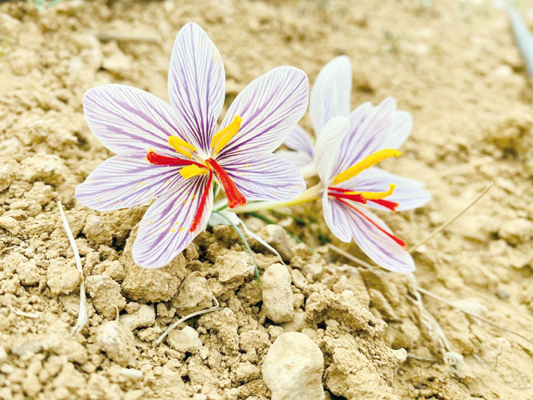A chance encounter with an endangered wild saffron flower has inspired a young Jordanian to start a business focused on the sustainability of the crop.
Bisher Thneebat, a 27-year-old university student, started the first wild saffron harvesting project in Jordan, following four years of hard work in saffron propagation.
Thneebat, like many young people his age, likes to explore the outdoors and used to spend much of his time trekking in the mountains of Karak.
During his outdoor adventures, Thneebat noticed that wild saffron survives harsh weather conditions and doesn’t require watering or special environment to grow.
“This was my wake-up call,” Thneebat added.
Watching wild saffron was inspiring in two dimensions, he said. The first thing he noticed is that despite harsh weather conditions, wild saffron grows into a beautiful flower, which for Thneebat, signifies that “where there’s a will, there’s a way”.
The second stroke of inspiration came from his thought that if saffron can grow in the wild, it can be domesticated and turned into a source of income, he said.

According to Thneebat, saffron is harvested from saffron crocus, also called the Crocus Sativus flower. The harvesting process takes a long time because it can only be done by hand, and requires extreme caution and care.
“A kilo of saffron requires 150,000 flowers,” Thneebat added.
Due to its labour intensity, saffron is considered the most expensive spice and is very profitable for farmers, he said.
Saffron is one of the lowest-risk crops, as it is not affected by frost or high temperatures and it can live for an entire year without irrigation. Additionally, the bulb can live on very little rainfall, he explained.
“Moabi or wild saffron is an endangered wild saffron listed on International Union for Conservation of Nature (IUCN) Red List for endangered species, and grows only in Jordan and Palestine,” Thneebat said.
The harvest season for saffron begins in early October and ends in December. However, the harvest season might change depending on temperatures, he said.
“Moabi saffron is a plant that lives within a temperature range of -15 to 45 Celsius, and as a member of the Iris family, it prefers cold weather,” Thneebat added.
Thneebat added that saffron production increases annually, as bulbs planted in the soil double within four years, up to approximately seven times, which allows farmers to expand production.
--
Source: Jordan Times.
